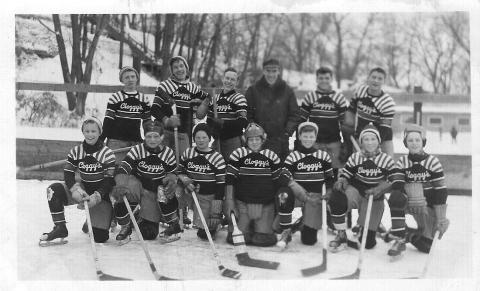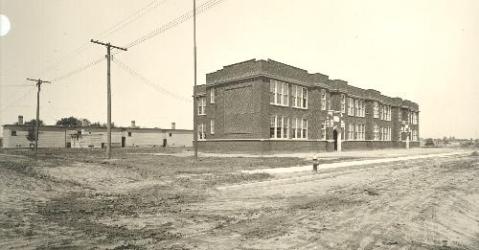Archive for the ‘Sibley Field’ Tag
Sibley Field Flattened 1923
Sibley Field was one of the bigger challenges the park board faced when it came to building neighborhood recreation parks. 1923 was a very busy year as the park board developed Sibley Field, Chicago Avenue (Phelps) Field and Nicollet (MLK) Field in south Minneapolis, Folwell Field and Sumner Field in north Minneapolis and Linden Hills Field in southwest. But Sibley may have been the biggest challenge, because all four corners of the park were at different grades. Park superintendent Theodore Wirth wrote afterwards that Sibley was one of the only projects for which costs had been seriously underestimated due to the expense of moving dirt. To create level fields, park board crews used a steam shovel and horse teams to move 68,000 cubic yards of earth.
This is one of my favorite photos of neighborhood park construction. It shows dramatically how much earth had to be moved to create an expanse of level ground suitable for playing fields. I wonder if the home owners who sat near the precipice on 20th Avenue South were ever worried.
As I noted in my profile of Sibley Field on the park board’s website, Wirth wrote in the park board’s 1923 annual report that the “formerly unsightly low land” was brought to an “attractive and serviceable” grade.
Photos like this reinforce my admiration for all the people — from neighborhood residents to city leaders — who envisioned, supported, planned and paid for the parks that have made life in Minneapolis better for many generations.
David C. Smith
Triangle Followup: Prospect Park, Laurel and Sibley Triangles
Summer gardens are gone and I never got a good picture of another beautiful park triangle: Sibley Triangle located in northeast Minneapolis where Washington Street NE and Fifth Street NE meet. (For earlier posts on park triangles see this one on small triangles and this one on triangles in Prospect Park.) Every time I was in the neighborhood I was without camera, so if any readers have photos I’d like to post them. The garden is planted and maintained by volunteer Robin Russell, who has done a fantastic job. Sibley Triangle is another of Minneapolis’s six triangles that are listed as 0.01 acre. The park board acquired the little triangle from the city in 1920.
Like Sibley Field in south Minneapolis, it was named for Henry Hastings Sibley, but the triangle was named first. Apparently having a little street triangle named for Sibley did not sufficiently honor Minnesota’s first governor, so the larger neighborhood park was named for him too — three years later. (The larger park had previously been referred to as Cedar Avenue Heights Park. See more here.)
I was also informed by Michelle Kellogg of the park board that the volunteer who deserves the credit for maintaining the tranquil gem of Laurel Triangle in Bryn Mawr is Patty Wycoff. Thanks Patty!
Finally, I spent an enjoyable evening in July with the Prospect Park Garden Club at the home of Mary Alice Kopf talking about triangles and other parks in the neighborhood. Thanks to Julie Wallace who dug up the info from neighborhood association documents that Bedford Triangle and Clarence Triangle were altered in 1979. Bedford Triangle was obliterated and the street on one side of Clarence Triangle was removed so it now appears to be part of the yard on the northwest corner of the Bedford and Clarence intersection. The only thing that suggests it is not private property is a boulder on the corner — as in the other Prospect Park triangle parks. I learned that night that the boulders were unearthed during the construction of I-94 through the neighborhood.
David C. Smith
Sibley Field
One of the most heavily used playgrounds in Minneapolis for a few decades was Sibley Field at 39th and Longfellow in south Minneapolis. Now, thanks to the efforts of Annie Olson who worked at Sibley Field for several years, we have found some historic photos of activities at Sibley Field.
One of my favorites is this hockey team wearing Cloggy’s sweaters.

Cloggy’s 1952 hockey team at Sibley Field (Minneapolis Park and Recreation Board). ** Please see the comments by Ron Jelmo below on this photo.
In more recent times, Cloggy’s was a bar at 34th and 54th, but that’s quite a distance from Sibley Field. Not exactly a neighborhood bar. The photo provides no identification of the players or coaches. Does anyone know the story of this Cloggy’s team or Cloggy’s sponsorship of teams in general?
Another group of unidentified players is this 1961 cub hockey team? Anybody know any of these kids?
Another picture that I found interesting is this one of unnamed staff or volunteers at Sibley Field. The year is also unknown, although I’m guessing early 1960s.
I like this photo because of the “BPC” on the t-shirts. BPC was the acronym for Board of Park Commissioners, the official name of the Minneapolis park board until it was changed in 1969 to Minneapolis Park and Recreation Board. The new name was intended to emphasize the significant responsibilities of the park board for recreation programs — something that didn’t exist when the BPC was created in 1883. I presume they are standing in front of the recreation center that was built in 1924 and stood until the current rec center was built in 1971. Can anyone identify the people in this picture and whether they were BPC employees or Sibley Field volunteers? Interesting composition in front of the men’s room.
Sibley Field was one of the most active parks in Minneapolis from 1946 when it was one of only five city parks that offered year-round programming. The other four year-round parks were Folwell, Nicollet (King), Logan and Loring; North Commons was added to that group in 1956.
This series of photos (stapled together) suggests the wide range of activities offered — and groups served — at the park. Two years after this photo was taken Sibley Field became one of nine recreation centers in Minneapolis to offer programs for senior citizens, too. The seniors met one morning a week at the park. The program was modeled after a similar program that had first been tried at Loring Park in 1960.
A search of old Minneapolis Morning Tribunes reveals that the Cedar Avenue Heights neighborhood (the park was originally Cedar Avenue Heights Field) began to be developed in 1909-1910. Newspapers also reveal that petitions for a park in Cedar Avenue Heights, which the park board received in September, 1921, followed the creation of a neighborhood improvement association in March of that year (Minneapolis Morning Tribune, March 28, 1921). The Tribune reported that the neighborhood improvement association was founded primarily to promote the creation of a double track on the street car line on Cedar Avenue from Lake Street to 42nd Street and an extension of the line south of 42nd. (Park commissioners also appeared at the City Council to advocate extending the Cedar Avenue car line to serve the new bath house at Lake Nokomis.) The paper also speculated that day that the association would also support the construction of a new Nokomis High School, which was eventually named Roosevelt High School.
The impetus for the formation of the Cedar Heights Improvement Association in March, 1921 was almost certainly the opening of the new Miles Standish school in January of that year. The school quickly became the center of the community. The Tribune reported that 900 people attended the first meeting of the neighborhood improvement association at the school.

The new Miles Standish School facing what is now Standish Avenue at 40th Street in 1922. The school was significantly enlarged in 1923, just two years after it was built. (Minneapolis Public Schools)
Cedar Avenue Heights Field was not the first playing field in the neighborhood. Tribune articles about amateur baseball in 1909 refer to a baseball field — the home field of the Prince Realty team — at Cedar and 42nd Street. I’ve never seen a picture of that field. If you have, let me know where I can find one.
David C. Smith
 Comments (2)
Comments (2)




